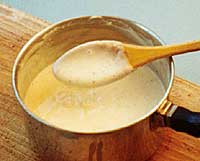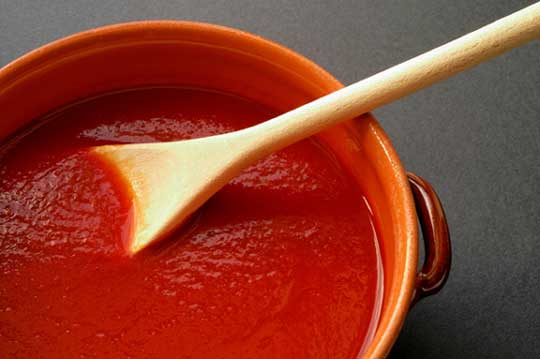Picture this: Homemade, fresh pasta noodles straight out of the pot after being boiled. Smell their bread-y, pasta-y goodness. Feel the warm steam against your face. Slippery yet satisfying. The sensation takes you back to your childhood and mom putting a big bowl of "spisghetti" in front of you with tender care.
Now picture all of your fond memories that surround pasta. Birthdays, weddings, your trip to Roma, the guy you met on your trip to Roma... Now remove the sauce (from the pasta, not the guy). Kind of depressing, isn't it? While we all love fresh pasta, the sauce takes center stage in every dish. In fact, sauces reign supreme in most dishes and marry the flavors together while creating a fine balance within the flavor profile. Have you ever stopped to appreciate the Hollandaise on your Eggs Benedict or the creamy Béchamel in your lasagna? You might want to take a moment to say thank you before you hurt your favorite sauce's feelings. However, if your favorite sauce is "Prego," I am going to need you to increase your fine culinary appetite just a smidgen.
Ever wonder where all of those sauces come from? Well, just like people, sauces come from their mothers (duh!). In the 19th century, the "King of Chefs," Chef Antonin Carême, gathered all of the poor orphan sauces in the French cooking world and organized them underneath four Mother Sauces so they could all find loving, happy homes. In the 20th century, the "Father of French Cuisine," Chef Auguste Escoffier, took all of the foster child sauces and put them in permanent homes when he further modernized Carême's placement system. Escoffier defined the five mother sauces that are in existence in modern cooking. Not to get too graphic, but when a mother sauce and some daddy ingredients love each other very much, they get together and have a daughter sauce. The five Big Mama's are Velouté, Béchamel, Tomate, Espagnole, and Hollandaise. No, Tabasco and Cholula were not mistakenly left off the list. The daughter sauces are endless...
To make sure all my TCP Friends are educated sauce connoisseurs, check out some more about the Big Mama's:
From the French adjectival form of velour, meaning velvety
Velouté is a sauce made from a white roux, stock, bouquet garni and mushroom peelings. Velouté is most often used with poultry or seafood dishes. Velouté daughter sauces include Sauce Vin Blanc, Albufera, Allemande and Normandie, to name a few.
Named after the Marquis de Béchamel (Louis de Béchameil, Marquis de Nointel) (1630-1703), a financier who held the honorary post of chief steward to Louis XIV
Simply put, Béchamel is Velouté with milk instead of stock. It is made with a white roux, milk, onion with clove, and salt. Béchamel is often used in lasagna and croquet-monsieur. The daughter sauces of Béchamel include Mornay, Nantua, Mustard Sauce and Soubise Sauce.
Possible origins of the name: The Spanish cooks of Louis XIII's bride, Anne, helped to prepare their wedding feast, and insisted upon improving the rich brown sauce of France with Spanish tomatoes. This new sauce was an instant success, and was gratefully named in honor of its creators. Espagnole’s role in sauce making was so paramount, the Jules Gouffé suggested changing the name to Française.
Espagnole is made with fonds brun (brown stock, usually veal stock), roux brun (brown roux), bacon, carrot, onion, thyme, bay leaf (bouquet garni) and tomato paste. Espagnole daughter sauces include Sauce Africaine, Sauce Bigarade, Sauce Bourguignonne, Sauce aux Champignons, Sauce Charcutiére, Sauce Chasseur, Sauce Chevreuil and Demi-glace. Espagnole is rarely used in modern kitchens due to the cost of ingredients and lengthy preparation time.
Named Hollandaise because it was believed to have mimicked a Dutch sauce for the state visit to France of the King of the Netherlands.
Hollandaise is a hot emulsification sauce or Emulsifiée (Froide et Chaude). Emulsified sauces are sauces in which an amount of fat, in the form of oil or butter, is introduced into a water-based liquid. Protein stabilizes the emulsion and keeps it from separating. In most emulsions, egg yolks are used as the protein because they contain lecithin. Mayonnaise is the cold version of Hollandaise and is sometimes referred to as the mother (or Little Mama, if you prefer) of cold emulsified sauces. Although Mayonnaise is not a traditional mother sauce, it does have daughter sauces that are derived from it, including various aiolis, tartar sauce, rémoulade and gribiche. Hollandaise uses heat and mixes egg yolks with a fusion of water and black peppercorns and butter. The most common daughter sauce of Hollandaise is Béarnaise, which includes a reduction of shallots, tarragon and a bouquet garni. The most common use for Hollandaise is in Eggs Benedict.
After all of that, I am HUNGRY! With my ode to sauces complete, I am off to tell my favorite sauces how much my stomach and I appreciate and love them.
 |
| My first homemade Mayonnaise :-) |
Stay saucy and be blessed TCP Friends!






No comments:
Post a Comment